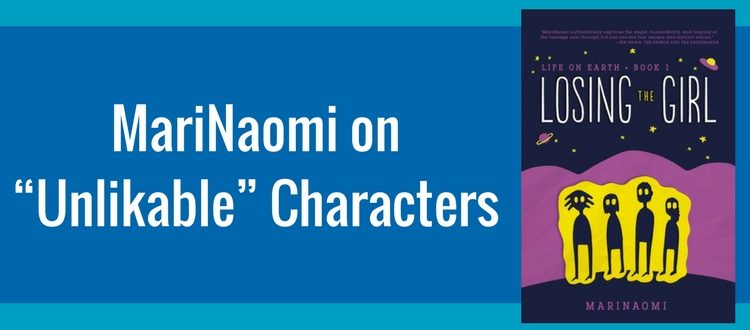Graphic Novelist MariNaomi on “Unlikable” Characters

By Greg Hunter, Associate Editorial Director, Graphic Universe
I was a fan of MariNaomi’s graphic memoirs before reading the proposal for her new YA graphic novel Losing the Girl. Even so, the book’s treatment really struck me with the complexity, range, and unvarnished portrayal of its characters. In celebration of the book’s pub month, I spoke with Mari about writing characters and keeping them complicated.

A conversation with MariNaomi
Greg: The teenagers in Losing the Girl are all distinct from one another, and all recognizable too. But also, the book is never afraid to show them being selfish, self-sabotaging, etc. I don’t think there are any unlikable people among the lead characters, but there are a ton of unlikable behaviors. And that’s a big deal, because not all stories observe that distinction.
Did you have anything like a mission or a guiding philosophy as you told the story? ‘I’m going to show the humanity in these people, regardless of the mistakes they make.’ Or was it more a product of trying to be as realistic as possible in the depictions of the kids?
Mari: One of my pet peeves is two-dimensional character portrayal, in books, movies, television, etc., so this is something I think about a lot. You see it sometimes even in real life, when a person is demonized or portrayed as A Good Person by someone who loves them or hates them. But the thing is, there really isn’t such a thing as that kind of person. My interest in humans and life in general are the challenges and nuances. The mixed feelings. So I’m glad that this is coming across in my book!
Firstly, each character in the Life on Earth trilogy was inspired by somebody I’ve known. Nigel, for example, is a cross between two of my high school boyfriends, plus a little bit of me thrown in there. (In fact, a little bit of me is in almost every character.) Maybe by basing characters off of real people, it was easier for me to look at them from all sides.
More importantly, this book was inspired by my real-life attempt at understanding my ex-friend’s betrayal of me. I was trying to step into her shoes, to feel less angry about what she’d done, and see things from her point of view. It wasn’t an easy thing to do, and I’m not glad for the experience, but I do think it made the characters in my story more interesting than if my friendship had gone smoothly.

Greg: Later in the series, readers will see some indisputably toxic behaviors from certain people. But you could say that both Nigel and Brett are, I don’t know, toxicity risks. Nigel is pushy and overeager when it comes to romance. Brett is emotionally remote in ways that hurt people around him. Did the idea of toxic masculinity inform the writing of your characters?
Mari: I never thought of them in that way! Nigel’s pushiness comes from a place of self-absorption, as does Brett’s emotional unavailability. They’re both sensitive people, but unfortunately that sensitivity is mostly centered around what’s going on in their own lives. But neither of them want to hurt anybody, and any sort of entitlement they exhibit is more childish than cultural. In other words, they’ll grow out of it.
Unlikable characters elsewhere
Greg: Who are some of your favorite flawed-to-unlikable characters from fiction/pop culture?
Mari: In literature, I really love Archie from Melissa Banks’s book The Girls’ Guide to Hunting and Fishing—he is a horrible boyfriend for the protagonist, but you can see how he charms her, and I love him for his vulnerability and flaws.
Tammy the librarian from the TV show Parks and Rec cracks me up. Rupert Pupkin and Marsha from the movie King of Comedy are both hilarious and terrible and, most importantly, sympathetic. I’d never want to know them in real life, but I could watch them in movies all day long. Severus Snape from the Harry Potter books and movies might be the most popular complicated character I’ll list here.

Where to find Losing the Girl
Losing the Girl is available through lernerbooks.com, Barnes & Noble, Amazon, IndieBound, and all major distributors. Plus, read a Q&A with Mari here.
Look for Gravity’s Pull, the second installment of the Life on Earth series, in Spring 2019.
Comments